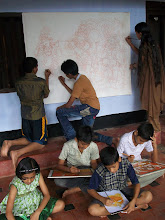Mural art in India traces back to Ajanta and even earlier. In Kerala many of those traditions are still kept alive.Like Koodiyattom(Sanskrit Drama) for example.Whereas in rest of India these Classical art forms are extinct for lack popular support.
Mural Artists are trained to execute murals from the size of a (mughal) miniature, to end to end walls that span the sacred temples and public spaces.They are trained to execute murals in the classical tradition using natural dyes and pigments.
The mural 'Girija Kalayanam depicting the story of the wedding of Siva and Parvathi- a non-canonical version was done by Sasi Edavarad Gurukkal at a private residence in 2002 strictly adhering to traditional methods : (http://www.facebook.com/photo.php?pid=30025169&l=e39a227d5b&id=1110180084)
Mural painting is in a period of transition where it is trying to reinvent itself on surfaces other than the sacred walls of temples.
All other pics you have seen on the facebook of artist Sasi Edavarad
Sasi Edavarad on Facebook
are in Acrylic both on wall( for example the 6 foot by 5 foot Manavedan completed in Dec2009)
and on canvas and paper.
Mahua Art Gallery had categorised Murals under the Folk art section
Ambalpoika: A swim in the Lily pond by Sasi Edavarad
and some think it is tribal art.
In fact, Mural painting is to art what Hindusthani sangeeth is to music.
It is deep and intense and needs an appreciation of what is called Classical Indian sense of beauty , aesthetics and poetics.
skip to main |
skip to sidebar

Dhyanasankalpam is an Openstudio for Indian (Kerala) murals,and here we regard the pursuit of pure aesthetic experience,as Yoga. Its an exalted experience not just for the individual artist but for the whole community and even humanity, that which touches and consorts with every aspect of Indian life. We at Dhyanasankalpam create works that would last a millennium or two if not for posterity, like the murals of Ajanta.All that you have to ensure for us are walls that would last just as long.
Followers
Blog Archive
-
▼
2010
(53)
-
▼
March
(16)
- "My River' -an Artists camp in association with N...
- Day 12 at 'the Flute Recital'-mural in acrylic on ...
- Saint Tyagaraja's Nauka Charitam,illustrated by Sa...
- Putana from Vishnu Temple in Pundareekapuram,Kerala
- Krishna and a peacock from 16CAD,Trissur,Kerala
- The Handsome Lotus Plucker from Sittanavasal Cave ...
- Steady progress on the canvas at the open studio
- Clips of 'Netronmeelanam ' ceremony uploaded to Fa...
- Mural painting:a 'spent force' or a victim of 'w...
- Murals: Cross Section& Natural Pigments,dyes,miner...
- Minor Traditions in Indian Art (contd)
- The Kalighat School of Calcutta
- minor traditions (from Battala)in depicting gods p...
- Calendar Gods and Goddesses enter every Indian hom...
- Murals from various Kerala Temples by anonymous ar...
- Mural painting is to art what Hindusthani sangeeth...
-
▼
March
(16)
Our mission

- Dhyanasankalpam
- calicut, kerala, India
- The ageless sense of Indian aesthetics or concept of beauty,is reflected in Indian Murals.It is an open activity.It is team work and also a community based art form.DhyanaSankalpam -an Openstudio for Kerala Murals attempts to uphold the ageless traditions.



